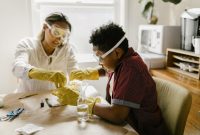
In recent years, the field of dental soft tissue regeneration has been experiencing significant advancements, capturing the attention of both professionals and enthusiasts in the education and how-to segments. By 2025, this market continues to evolve, driven by innovative techniques and materials aimed at improving patient outcomes. This comprehensive guide delves into the key trends shaping the dental soft tissue regeneration landscape, offering insights for educators and practitioners eager to stay updated with the latest developments.
The Growing Importance of Dental Soft Tissue Regeneration
Dental soft tissue regeneration is a crucial aspect of oral health care, focusing on repairing and restoring the gums and other soft tissues in the mouth. This field has gained prominence as more individuals seek treatments to address gum recession, periodontal disease, and other oral health concerns. With the global population becoming more aware of the impact of oral health on overall well-being, the demand for effective and innovative solutions in soft tissue regeneration has soared.
1. Advanced Biomaterials in Dental Soft Tissue Regeneration
Biomaterials play a pivotal role in dental soft tissue regeneration, offering scaffolds and matrices that support tissue growth. By 2025, advancements in biomaterials are expected to enhance the effectiveness and predictability of regenerative procedures.
- Collagen-Based Products: Collagen is widely used for its biocompatibility and ability to promote cell adhesion and growth. New formulations and delivery systems are being developed to improve clinical outcomes.
- Hyaluronic Acid Applications: Known for its moisture-retaining properties, hyaluronic acid is being integrated into various products to enhance wound healing and tissue regeneration in dental applications.
2. Innovative Techniques and Procedures
Modern techniques in dental soft tissue regeneration focus on minimally invasive approaches to reduce patient discomfort and recovery times.
- Pinhole Surgical Technique: This minimally invasive procedure addresses gum recession without the need for traditional gum grafting, offering quicker recovery and less discomfort.
- Guided Tissue Regeneration (GTR): Utilizing barrier membranes to direct the growth of new gum and bone tissue, GTR continues to evolve, benefiting from improvements in membrane materials and application techniques.
3. The Role of Growth Factors
Growth factors are naturally occurring proteins that encourage cell proliferation and differentiation. In dental soft tissue regeneration, they are utilized to enhance healing and tissue formation.
- Platelet-Derived Growth Factor (PDGF): PDGF is commonly used to stimulate tissue repair and regeneration, and innovations in its delivery are enhancing its therapeutic potential.
- Bone Morphogenetic Proteins (BMPs): Although traditionally associated with bone growth, BMPs are being explored for their potential benefits in soft tissue applications as well.
4. Digital Dentistry and Soft Tissue Regeneration
The integration of digital technologies in dentistry is transforming how practitioners approach soft tissue regeneration.
- 3D Printing: Custom scaffolds and models are being created through 3D printing, allowing for personalized treatment plans and improved surgical outcomes.
- Digital Imaging and Planning: Advanced imaging systems enable precise planning and execution of regenerative procedures, resulting in enhanced accuracy and patient satisfaction.
5. Education and Training for Practitioners
As the field evolves, continuous education and training are paramount for practitioners to keep up with the latest trends and techniques in dental soft tissue regeneration.
- Workshops and Seminars: Hands-on training sessions and seminars provide practitioners with the opportunity to learn and practice new techniques under expert guidance.
- Online Courses and Resources: The availability of online platforms allows for flexible learning, offering courses that cover both theoretical knowledge and practical applications.
FAQ
What are the most promising materials in dental soft tissue regeneration? Collagen and hyaluronic acid are among the most promising materials, offering biocompatibility and promoting cell growth and healing.
How does the pinhole surgical technique differ from traditional gum grafting? The pinhole technique is less invasive, requiring no sutures, resulting in less discomfort and faster recovery compared to traditional gum grafting.
How is digital technology influencing dental soft tissue regeneration? Digital technology, including 3D printing and advanced imaging, is enhancing the precision and personalization of treatment plans, leading to improved outcomes.
Why are growth factors important in this field? Growth factors facilitate the natural healing process by encouraging cell growth and tissue formation, thus improving the effectiveness of regenerative treatments.
What educational resources are available for dental professionals? Dental professionals can access workshops, seminars, and online courses to stay updated on the latest regenerative techniques and practices.
Conclusion
As the dental soft tissue regeneration market continues to grow, driven by technological advancements and a deeper understanding of biological processes, staying informed about these trends is crucial for educators and practitioners alike. By embracing innovative materials, techniques, and technologies, the field is set to offer enhanced patient care and improved clinical outcomes. Continuous education and adaptation to new methods will ensure that professionals remain at the forefront of this dynamic and evolving industry.


